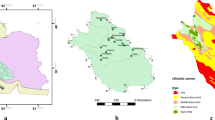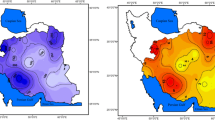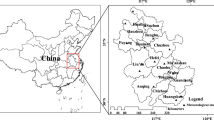Abstract
The study aims at regional and probabilistic evaluation of bivariate drought characteristics to assess both the past and future drought duration and severity in Bangladesh. The procedures involve applying (1) standardized precipitation index to identify drought duration and severity, (2) regional frequency analysis to determine the appropriate marginal distributions for both duration and severity, (3) copula model to estimate the joint probability distribution of drought duration and severity, and (4) precipitation projections from multiple climate models to assess future drought trends. Since drought duration and severity in Bangladesh are often strongly correlated and do not follow same marginal distributions, the joint and conditional return periods of droughts are characterized using the copula-based joint distribution. The country is divided into three homogeneous regions using Fuzzy clustering and multivariate discordancy and homogeneity measures. For given severity and duration values, the joint return periods for a drought to exceed both values are on average 45% larger, while to exceed either value are 40% less than the return periods from the univariate frequency analysis, which treats drought duration and severity independently. These suggest that compared to the bivariate drought frequency analysis, the standard univariate frequency analysis under/overestimate the frequency and severity of droughts depending on how their duration and severity are related. Overall, more frequent and severe droughts are observed in the west side of the country. Future drought trend based on four climate models and two scenarios showed the possibility of less frequent drought in the future (2020–2100) than in the past (1961–2010).













Similar content being viewed by others
References
Adnan S (1993) Living without floods: lessons from the drought of 1992. Research and Advisory Services, Dhaka
Ayvaza MT, Karahana H, Aral MM (2007) Aquifer parameter and zone structure estimation using kernel-based fuzzy C-means clustering and genetic algorithm. J Hydrol 343(3–4):240–253. https://doi.org/10.1016/j.jhydrol.2007.06.018
Bonaccorso B, Cancelliere A, Rossi G (2003) An analytical formulation of return period of drought severity. Stochastic environ. Res Risk Assess 17(3):157–174. https://doi.org/10.1007/s00477-003-0127-7
Brown C, Meeks R, Hunu K, Yu W (2011) Hydroclimatic risk to economic growth in sub-Saharan Africa. Clim Chang 106(4):621–647. https://doi.org/10.1007/s10584-010-9956-9
Brown C, Meeks R, Ghile Y, Kenneth H (2013) Is water security necessary? An empirical analysis of the effects of climate hazards on national-level economic growth. Phil Trans R Soc A 371(2002):20120416. https://doi.org/10.1098/rsta.2012.0416
Burn DH, Goel NK (2000) The formation of groups for regional flood frequency analysis. Hydrol Sci J 45(1):97–112. https://doi.org/10.1080/02626660009492308
Cancelliere A, Salas JD (2004) Drought length properties for periodic-stochastic hydrologic data. Water Resour Res 40(2):W02503
Chebana F, Ouarada T (2011) Multivariate quantiles in hydrological frequency analysis. Environmetrics 22(1):63–78. https://doi.org/10.1002/env.1027
Chebana F, Ouarda T (2007) Multivariate L-moment homogeneity test. Water Resour Res 43(8):W08406. https://doi.org/10.1029/2006WR005639
Cook BI, Smerdon JE, Seager R, Coats S (2014) Global warming and 21st century drying. Clim Dyn 43(9-10):2607–2627. https://doi.org/10.1007/s00382-014-2075-y
Chen L, Singh VP, Guo S, Mishra AK, Guo J (2013) Drought analysis based on copulas. J Hydrol Eng 18(7):797–808. https://doi.org/10.1061/(ASCE)HE.1943-5584.0000697
Dai A (2013) Increasing drought under global warming in observations and models. Nat Clim Chang 3(1):52–58. https://doi.org/10.1038/nclimate1633
Dai A (2012) Increasing drought under global warming in observations and models. Nat Clim Chang 3(1):52–58. https://doi.org/10.1038/NCLIMATE1633
Dai A (2011) Characteristics and trends in various forms of the palmer drought severity index during 1900–2008. J Geophys Res 116(D12):D12115. https://doi.org/10.1029/2010JD015541
Dash BK, Rafiuddin M, Khanam F, Islam MN (2012) Characteristics of meteorological drought in Bangladesh. Nat Hazards 64(2):1461–1474. https://doi.org/10.1007/s11069-012-0307-1
Douglas EM, Vogel RM, Kroll CN (2002) Impact of streamflow persistence on hydrologic design. J Hydrol Eng 7(3):220–227. https://doi.org/10.1061/(ASCE)1084-0699(2002)7:3(220)
Dunn JC (1974) A fuzzy relative of the ISODATA process and its use in detecting compact, well separated clusters. J Cyber 3:32–57
Funk C (2009) New satellite observations and rainfall forecasts help provide earlier warning of African drought. The Earth Observer 21:23–27
Genest C, Favre AC (2007) Everything you always wanted to know about copula modelling but were afraid to ask. J Hydrol Eng 12(4):347–368. https://doi.org/10.1061/(ASCE)1084-0699(2007)12:4(347)
Genest C, Rivest LP (1993) Statistical inference procedures for bivariate Archimedean copulas. J Am Stat Assoc 88(423):1034–1043. https://doi.org/10.1080/01621459.1993.10476372
Gonzale’z J, Valde’s JB (2003) Bivariate drought recurrence analysis using tree ring reconstructions. J Hydrol Eng 8(5):247–258. https://doi.org/10.1061/(ASCE)1084-0699(2003)8:5(247)
Goyal M, Sharma A (2016) A fuzzy c-means approach regionalization for analysis of meteorological drought homogeneous regions in western India. Nat Hazards 84(3):1831–1847. https://doi.org/10.1007/s11069-016-2520-9
Gregory JM, Mitchell JFB, Brady AJ (1997) Summer drought in northern mid latitudes in a time-dependent CO2 climate experiment. J Clim 10(4):662–686. https://doi.org/10.1175/1520-0442(1997)010<0662:SDINMI>2.0.CO;2
Griffiths ML, Bradley RS (2007) Variations of twentieth century temperature and precipitation extreme indicators in the northeast United States. J Clim 20(21):5401–5417. https://doi.org/10.1175/2007JCLI1594.1
Hao Z, AghaKouchak A, Nakhjiri N, Farahmand A (2014) Global integrated drought monitoring and prediction system. Sci Data 1(140001):1–10. https://doi.org/10.1038/sdata.2014.1
Heim RR (2002) A review of twentieth-century drought indices used in the United States. Bull Am Meteorol Soc 83:1149–1165
Hosking JRM, Wallis JR (1997) Regional frequency analysis—an approach based on Lmoments. Cambridge University Press, New York. https://doi.org/10.1017/CBO9780511529443
Jacob D, Reed DW, Robson A (1999) Statistical procedures for flood frequency estimation chapter 16, flood estimation, Vol 3. Institute of Hydrology, Wallingford, UK, pp 153–180
Joe H (1997) Multivariate model and dependence concepts. Chapman and Hall, London. https://doi.org/10.1201/b13150
Kao SC, Govindaraju RS (2010) A copula-based joint deficit index for droughts. J Hydrol 380(1-2):121–134. https://doi.org/10.1016/j.jhydrol.2009.10.029
Kendall MG (1975) Rank correlation measures. Charles Griffin, London
Khalili D, Farnoud T, Jamshidi H, Kamgar-Haghighi AA, Zand-Parsa SH (2011) Comparability analyses of the SPI and RDI meteorological drought indices in different climatic zones. Water Resour Manag 25(6):1737–1757. https://doi.org/10.1007/s11269-010-9772-z
Khedun CP, Chowdhary H, Mishra AK, Giardino JR, Singh VP (2012) Water deficit duration and severity analysis based on runoff derived from Noah land surface model. J Hydrol Eng 18(7):817–833
Lee JY, Wang B (2014) Future change of global monsoons in the CMIP5. Clim Dyn 42(1-2):101–119. https://doi.org/10.1007/s00382-012-1564-0
Madadgar S, Moradkhani H (2011) Drought analysis under climate change using copula. J Hydrol Eng 18(7):746–759. https://doi.org/10.1061/(ASCE)HE1943-55840000532
Mann HB (1945) Non-parametric tests against trend. Econometrica 13(3):245–259. https://doi.org/10.2307/1907187
Mazid MA, Mortimer MA, Riches CR, Orr A, Karmaker B, Ali A, Jabbar MA, Wade LJ (2005) Rice establishment in drought-prone areas of Bangladesh. In: Toriyama K, Heong KL, Hardy B (eds) Rice is life: scientific perspectives for the 21st century. International Rice Research Institute, Manila (Philippines)
McKee TB, Doesken NJ, Kleist J (1993) The Relationship of Drought Frequency and Duration to Time Scales. Proceedings of the 8th Conference on Applied Climatology 179–184
Mirabbasi R, Fakheri-Fard A, Dinpashoh Y (2012) Bivariate drought frequency analysis using the copula method. Theoretical and Applied Climatology, 191–206. doi:101007/s00704–011–0524-7
Mirakbari M, Ganji A, Fallah SR (2010) Regional bivariate frequency analysis of meteorological droughts. J Hydrol Eng 15(12):985–1000. https://doi.org/10.1061/(ASCE)HE1943-55840000271
Mishra AK, Singh VP (2010) A review of drought concepts. J Hydrol 391(1-2):202–216. https://doi.org/10.1016/j.jhydrol.2010.07.012
Mishra AK, Singh VP (2011) Drought modeling—a review. J Hydrol 403(1-2):157–175. https://doi.org/10.1016/j.jhydrol.2011.03.049
Mondal MH (2010) Crop agriculture of Bangladesh: challenges and opportunities. Bangladesh J Agril Res 35(2):235–245
Mortuza MR, Selmi S, Khudri MM, Ankur AK, Rahman MM (2014) Evaluation of temporal and spatial trends in relative humidity and dew point temperature in Bangladesh. Arab J Geosci (2014) 7(12):5037–5050. https://doi.org/10.1007/s12517-013-1139-3
NCEI (2017) National centers for environmental information. U.S. billion-dollar weather and climate disasters. NOAA, Washington, DC https://www.ncdc.noaa.gov/billions/
Nelsen RB (2006) An introduction to copulas. Springer, New York
Paul BK (1998) Coping mechanisms practised by drought victims (1994/5) in north Bengal, Bangladesh. Appl Geogr 18(4):355–373. https://doi.org/10.1016/S0143-6228(98)00026-5
Paulo AA, Pereira LS (2007) Prediction of SPI drought class transitions using Markov chains. Water Resour Manag 21(10):1813–1827. https://doi.org/10.1007/s11269-006-9129-9
Rafiuddin M, Dash BK, Khanam F, Islam MN (2011) Diagnosis of drought in Bangladesh using standardized precipitation index. International conference on environment science and engineering (ICESE 2011), Bali, Indonesia
Rahman AZ (2004) Correlations between green revolution and population growth: revisited in the context of Bangladesh and India. Asian Aff 26(2):41–60
Rahman MR, Lateh H (2016) Meteorological drought in Bangladesh: assessing, analysing and hazard mapping using SPI, GIS and monthly rainfall data. Environ Earth Sci 75(12). https://doi.org/10.1007/s12665-016-5829-5
Rajib MA, Mortuza MR, Selmi S, Ankur AK, Rahman, MM (2011) Spatial drought distribution in the Northwestern Part of Bangladesh. Proceedings of the Asian Conference on Sustainability, Energy and the Environment, Osaka, 2–5 June 2011, 568–575
Raziei TB, Saghafian Paulo AA, Pereira LS, Bordi I (2009) Spatial patterns and temporal variability of drought in western Iran. Water Resour Manag 23(3):439–455. https://doi.org/10.1007/s11269-008-9282-4
Reddy MJ, Ganguli P (2011) Application of copulas for derivation of drought severity–duration–frequency curves. Hydrol Process 26:1672–1685
Rossi G, Cancelliere A (2002) Early warning of drought: development of a drought bullettin for Sicily. Proc 2nd international conference “New trends in water and environmental engineering for safety and life: eco-compatible solutions for aquatic environments” Capri, Italy, June 24–28, 2002, pp 1–12
Sadri S, Burn DH (2014) Copula-based pooled frequency analysis of droughts in the Canadian prairies. J Hydrol Eng 19(2):231–239
Salas JD (2005) Characterizing the severity and risk of drought in the Poudre River, Colorado. J Water Resour Plan Manag 131(5):383–393. https://doi.org/10.1061/(ASCE)0733-9496(2005)131:5(383)
Salvadori G, De Michele C (2004) Frequency analysis via copulas: theoretical aspects and applications to hydrological events. Water Resour Res 40(12):W12511. https://doi.org/10.1029/2004WR003133
Santos JF, Portela MM, Pulido-Calvo I (2011) Regional frequency analysis of drought in Portugal. Water Resour Manag 25(14):3537–3558. https://doi.org/10.1007/s11269-011-9869-z
Serfling R, Xiao P (2007) A contribution to multivariate L-moments: L-comoment matrices. J Multivar Anal 98(9):1765–1781. https://doi.org/10.1016/jjmva200701008
Shahid S (2008) Spatial and temporal characteristics of droughts in the western part of Bangladesh. Hydrol Process 22(13):2235–2247. https://doi.org/10.1002/hyp6820
Shahid S, Behrawan H (2008) Drought risk assessment in the western part of Bangladesh. Nat Hazards 46(3):391–413. https://doi.org/10.1007/s11069-007-9191-5
Sharmila S, Joseph S, Sahai AK, Abhilash S, Chattopadhyay R (2015) Future projection of Indian summer monsoon variability under climate change scenario: an assessment from CMIP5 climate models. Glob Planet Chang 124:62–78. https://doi.org/10.1016/j.gloplacha.2014.11.004
Sheffield J, Wood EF (2008) Projected changes in drought occurrence under future global warming from multi-model, multi-scenario, IPCC AR4 simulations. Clim Dyn 31(1):79–105. https://doi.org/10.1007/s00382-007-0340-z
Sheffield J, Wood EF, Roderick ML (2012) Little change in global drought over the past 60 years. Nature 491(7424):435–438. https://doi.org/10.1038/nature11575
She D, Mishra AK, Xia J, Zhang L, Zhang X (2016) Wet and dry spell analysis using copulas. Int J Climatol 36(1):476–491. https://doi.org/10.1002/joc.4369
Shiau JT (2006) Fitting drought duration and severity with two dimensional copulas. Water Resour Manag 20(5):795–815. https://doi.org/10.1007/s11269-005-9008-9
Shiau JT, Feng S, Nadarjah S (2007) Assessment of hydrological droughts for the Yellow river basin. China, using copulas. Hydrol Process 21(16):2157–2163. https://doi.org/10.1002/hyp.6400
Shiau JT, Modarres R (2009) Copula-based drought severity-duration frequency analysis in Iran. J Appl Meteorol 16(4):481–489. https://doi.org/10.1002/met.145
Shiau JT, Shen HW (2001) Resource analysis of hydrologic droughts of different severity. J Water Resour Plan Manag 127(1):30–40. https://doi.org/10.1061/(ASCE)0733-9496(2001)127:1(30)
Shukla S, Steinemann AC, Lettenmaier DP (2011) Drought monitoring for Washington state: indicators and applications. J Hydrometeorol 12(1):66–83. https://doi.org/10.1175/2010JHM1307.1
Sklar A (1959) Fonctions de répartition á n dimensions et leurs marges. Publications de l’Institut de Statistique de l’Université de Paris 8:229–231
Song S, Singh VP (2010a) Meta-elliptical copulas for drought frequency analysis of periodic hydraulic data. Stoch Environ Res Risk Assess 24(3):425–444. https://doi.org/10.1007/s00477-009-0331-1
Song S, Singh VP (2010b) Frequency analysis of droughts using the Plackett copula and parameter estimation by genetic algorithm. Stoch Environ Res Risk Assess 24(5):783–805. https://doi.org/10.1007/s00477-010-0364-5
Sperber KR, Annamalai H, Kang IS, Kitoh A, Moise A, Turner A, Wang B, Zhou T (2012) The Asian summer monsoon: an intercomparison of CMIP5 vs CMIP3 simulations of the late 20th century. Clim Dyn 41(9-10):2711–2744. https://doi.org/10.1007/s00382-012-1607-6
Svoboda M, Lecomte D, Hayes M, Heim R, Gleason K, Angel J et al (2002) The drought monitor. Bull Am Meteorol Soc 83:1181–1190
Thrasher B, Maurer EP, McKellar C, Duffy P (2012) Technical note: bias correcting climate model simulated daily temperature extremes with quantile mapping. Hydrol Earth Syst Sci 16(9):3309–3314. https://doi.org/10.5194/hess-16-3309-2012
Wang B, Yim SY, Lee JY, Liu J, Ha KJ (2014) Future change of Asian-Australian monsoon under RCP 45 anthropogenic warming scenario. Clim Dyn 42(1-2):83–100. https://doi.org/10.1007/s00382-013-1769-x
WARPO (2005) Living in the Coast, Series 4 Urbaization, http://wwwwarpogovbd/rep/liv/living4pdf. Accessed 09 September 2014
WEF (2015) Global Risks 2015, 10th edn. World Economic Forum, Geneva http://www3.weforum.org/docs/WEF_Global_Risks_2015_Report15.pdf
Wong G, Lambert MF, Leonard M, Metcalfe AV (2010) Drought analysis using trivariate copulas conditional on climate states. J Hydrol Eng 15(2):129–141. https://doi.org/10.1061/(ASCE)HE.1943-5584.0000169
World Bank (2016) High and dry: climate change, water, and the economy. World Bank. http://www.worldbank.org/en/topic/water/publication/high-and-dry-climate-change-water-and-the-economy, Washington, DC. https://doi.org/10.1596/K8517
Zhang JY, Hall MJ (2004) Regional flood frequency analysis for the Gan-Ming River basin in China. J Hydrol 296:98–117
Zhang L, Singh VP (2007) Bivariate rainfall frequency distributions using Archimedean copulas. J Hydrol 332(1-2):93–109. https://doi.org/10.1016/j.jhydrol.2006.06.033
Zhang Q, Qi T, Singh VP, Chen YD, Xiao M (2015) Regional frequency analysis of droughts in China: a multivariate perspective. Water Resour Manag 29(6):1767–1787. https://doi.org/10.1007/s11269-014-0910-x
Acknowledgements
This study was supported in part by the Department of Defense under contract W912HQ150023. H. Li also acknowledges the support from the Office of Science of the U.S. Department of Energy as part of the Regional and Global Climate Modeling Program. Climate scenarios used were from the NEX-GDDP dataset, prepared by the Climate Analytics Group and NASA Ames Research Center using the NASA Earth Exchange, and distributed by the NASA Center for Climate Simulation (NCCS).
Author information
Authors and Affiliations
Corresponding author
Electronic supplementary material
ESM 1
(PDF 1048 kb)
Rights and permissions
About this article
Cite this article
Mortuza, M.R., Moges, E., Demissie, Y. et al. Historical and future drought in Bangladesh using copula-based bivariate regional frequency analysis. Theor Appl Climatol 135, 855–871 (2019). https://doi.org/10.1007/s00704-018-2407-7
Received:
Accepted:
Published:
Issue Date:
DOI: https://doi.org/10.1007/s00704-018-2407-7




